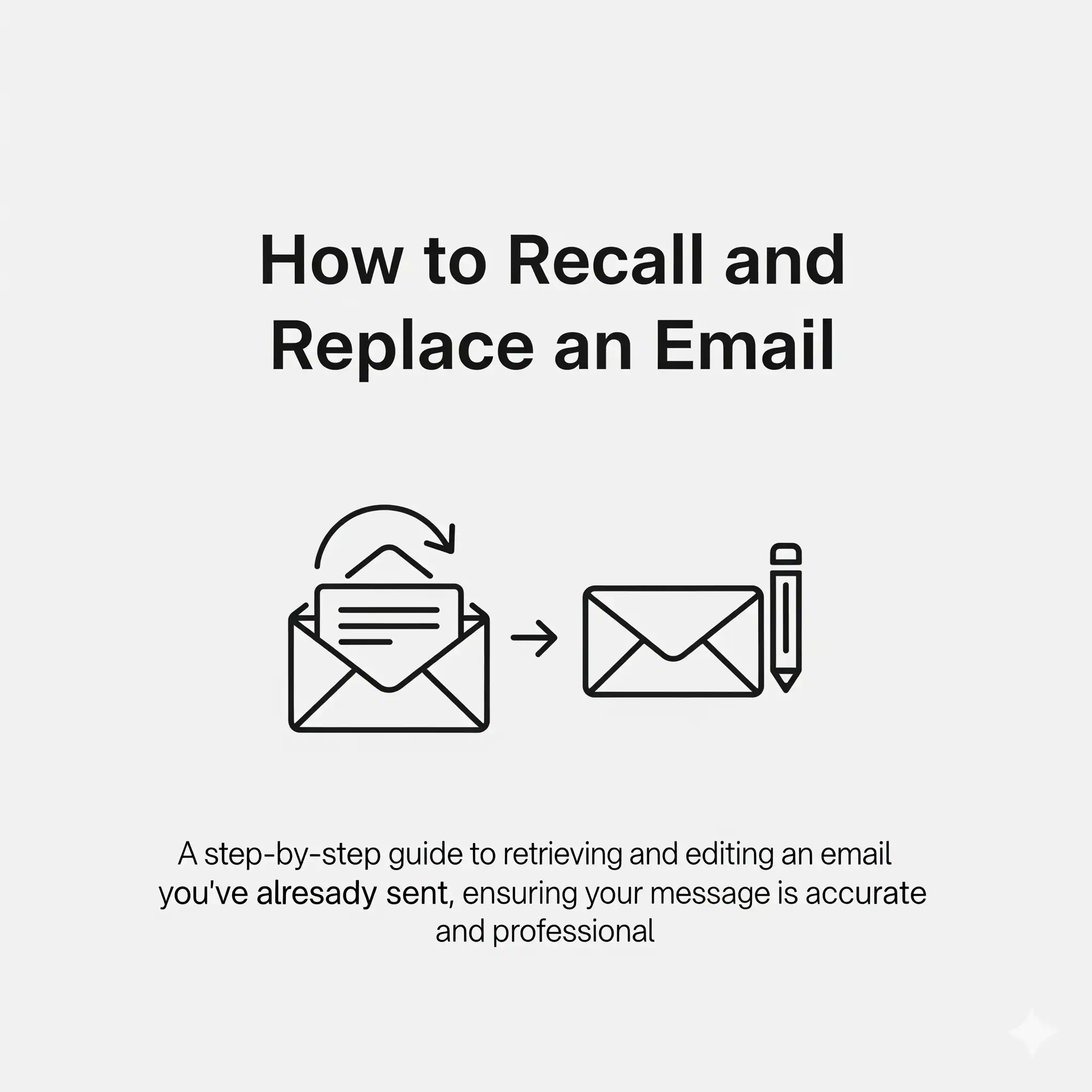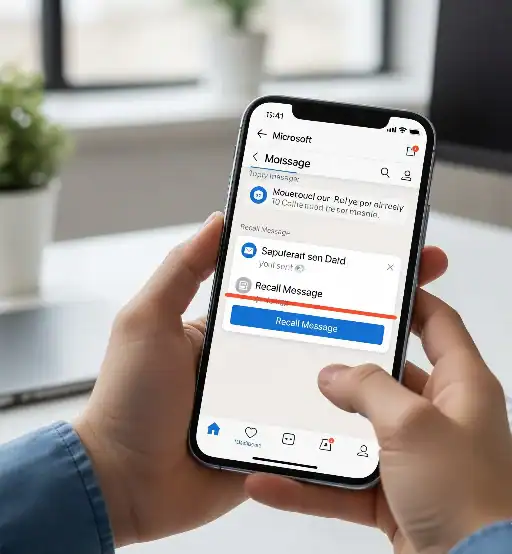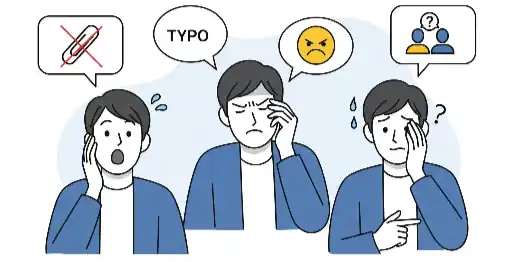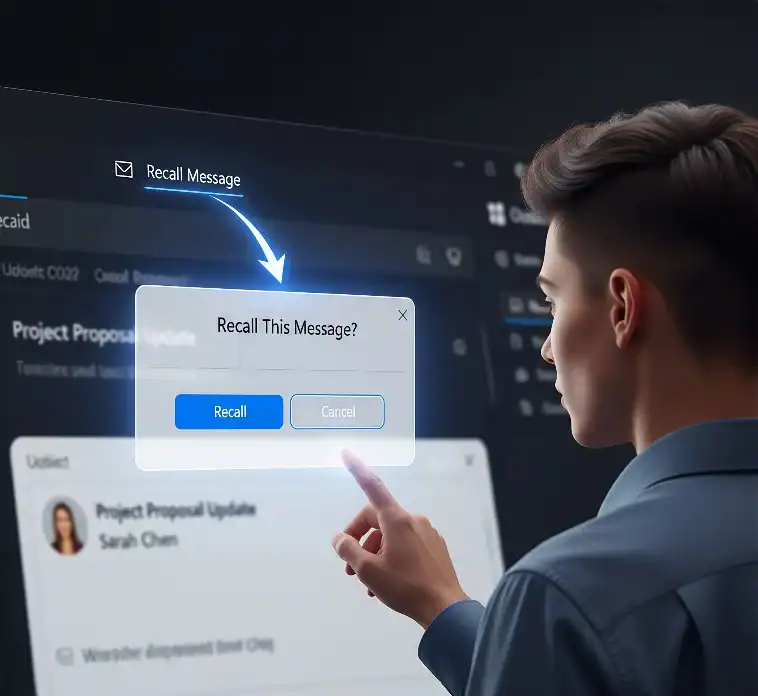Clicking Send on the wrong email can be like entering a nightmare. You clicked send, and then you knew you shouldn’t have. The good news? No matter, because Outlook can recall emails that would save the day.
This detailed guide has everything you need to know about how to recall an Outlook email. You’ll discover when recall is successful, how to use it with a step-by-step guide, and workarounds if you’re using a different platform.
What Is Email Recall in Outlook?
Email recall is a feature that enables you to delete or replace sent emails before the recipient has read them. Consider it an “undo” button for your emails. But email recall only functions under certain circumstances. Knowing these restrictions makes it easier to take advantage of the feature.
When Does Outlook Email Recall Work?
Essential Requirements for Email Recall
Email recall in Outlook works only when these conditions are met:
- Both sender and recipient must use Microsoft Exchange or Microsoft 365 accounts
- Both users must belong to the same organization
- The recipient hasn’t opened the email yet
- You’re using the Outlook desktop application (not web or mobile versions)
- The email reached the recipient’s inbox (not filtered to other folders)
Why These Limitations Exist
Microsoft designed email recall for internal organizational use. External recipients using Gmail, Yahoo, or other email services are unable to receive recall requests. The recall feature works through Exchange server communication between Outlook clients. The recall message cannot be sent directly to the recipient’s inbox, even if you are working in the same Exchange organization.
How to Recall an Email in Outlook Desktop
Step-by-Step Email Recall Process
Follow these detailed steps to recall an email in Outlook desktop:
Step 1: Open Your Sent Items
- Launch the Microsoft Outlook desktop application
- Click on “Sent Items” in the left navigation pane
- Locate the email you want to recall
Step 2: Open the Email
- Double-click the email to read it in its own window
- Open the email in a separate window (not just the preview pane)
Step 3: Access Recall Options
- Look for the Message tab in the ribbon
- For Classic Ribbon: Select Actions, then “Recall This Message”
- For Simplified Ribbon: Click Move, then Actions, then “Recall This Message”
Step 4: Choose Your Recall Method
- Choose “Delete unread copies of this message” to erase the email outright
- If you opted for replacement, then you can pick “Delete unread copies and replace with a new message” to send a correction
- Select “Tell me if recall succeeds or fails for each recipient” to receive notifications on how the recall is going
Step 5: Complete the Process
- Click OK to start the recall
- If you are replacing a message: Write your new one and click Send
How to Recall and Replace an Email

Sometimes you want to send a revised message instead of just purging the original.
Replacing Your Email Message
Choose Replace Option:
- Follow steps 1-3 from the previous section
- Select “Delete unread copies and replace with a new message”
- Click OK
Compose Your Replacement:
- A new message window opens with the original content
- Make necessary corrections or changes
- Review the message carefully before sending
- Click Send to deliver the replacement
Best Practices for Replacement Messages
- Keep the same subject line for consistency
- Briefly acknowledge the correction if appropriate
- Double-check all details before sending the replacement
- Consider calling or messaging urgent corrections
Recall Message Outlook 365: Modern Features
Microsoft 365 users have access to enhanced recall features and better reporting.
Enhanced Recall Capabilities
Outlook 365 provides:
- Improved success rates for email recall
- Better notification systems for recall status
- Enhanced compatibility across different Outlook versions
- More detailed recall reports
Checking Recall Success in Outlook 365
After initiating a recall, you’ll receive a “Message Recall Report” email. This report shows:
- Which recipients successfully had emails recalled
- Which recalls failed and why
- Timing information for each recall attempt
How to Recall an Email in Outlook Mac
Mac users cannot use the traditional recall feature. However, you can prevent sending mistakes with Undo Send.
Setting Up Undo Send on Mac
Enable Undo Send:
- Open Outlook for Mac
- Click Outlook in the menu bar
- Select Settings, then Composing
- Find the Undo Send section
- Use + or – buttons to set delay time (up to 20 seconds)
Using Undo Send:
- After clicking Send, an “Undo” prompt appears
- Click Undo within your set time limit
- The message reopens for editing
- Make corrections and send again
Maximizing Undo Send Effectiveness
- Set the maximum 20-second delay for best results
- Review emails carefully during the undo window
- Keep the Outlook window active after sending to see undo prompts
How to Recall Email in Outlook Web
Outlook web users cannot recall sent emails. Instead, use the Undo Send feature as your safety net.
Configuring Undo Send in Outlook Web
Setup Process:
- Sign in to Outlook.com
- Click Settings (gear icon)
- Navigate to Mail, then Compose and Reply
- Find the Undo Send slider
- Set delay time (up to 10 seconds)
Using Web Undo Send:
- After sending an email, watch for the undo notification
- Click Undo before the timer expires
- Edit your message and resend
Limitations of Web-Based Solutions
- Shorter undo window compared to Mac version
- No recall option for already-delivered emails
- Limited to 10-second maximum delay
Recall Message Outlook App iPhone and Mobile

Mobile Outlook apps don’t support email recall. Your only option is preventing send mistakes with careful review.
Mobile Email Best Practices
Before Sending:
- Always review recipient addresses
- Double-check attachments and content
- Use draft mode for important messages
- Consider delayed send for critical emails
After Sending Mistakes:
- Send a follow-up email with corrections
- Call recipients for urgent corrections
- Use simple subject lines like “CORRECTION: Previous Email”
How Long Does It Take to Recall an Email in Outlook?
Email recall speed depends on several factors affecting delivery and processing.
Typical Recall Timeframes
Immediate Scenarios (Under 1 Minute):
- Recipient is offline
- Email hasn’t been delivered to inbox yet
- Exchange server processes recall quickly
Standard Scenarios (1-5 Minutes):
- Normal server processing time
- Recipient online but hasn’t opened email
- Standard network conditions
Delayed Scenarios (5+ Minutes):
- Server delays or high traffic
- Complex organizational email routing
- Multiple recipients requiring individual processing
Factors Affecting Recall Speed
- Exchange server performance
- Network connectivity quality
- Recipient’s email client status
- Organizational email policies
Does the Recipient Know If I Recall an Email in Outlook?
This depends on timing and email client configuration. Notifications regarding recalled messages may or may not be sent to recipients.
When Recipients Get Notified
Notification Scenarios:
- Some Outlook versions show “Message recalled by sender”
- Timing between delivery and recall affects visibility
- Email client settings influence notification display
No Notification Scenarios:
- Recall processed before email delivery
- Recipient using non-Outlook email clients
- Specific organizational settings preventing notifications
Minimizing Recall Visibility
- Act quickly after sending mistakes
- Use recall immediately upon noticing errors
- Consider follow-up communication for transparency
Common Email Recall Scenarios

Understanding when to use email recall helps you respond appropriately to sending mistakes.
Wrong Recipient Situations
Internal Mix-ups:
- Sent to wrong department colleague
- Confused similar employee names
- Selected wrong person from address suggestions
Quick Solutions:
- Recall immediately if possible
- Send correction to intended recipient
- Inform wrong recipient if recall fails
Missing Attachment Problems
Common Attachment Issues:
- Forgot to attach important documents
- Attached wrong file version
- File corruption or formatting problems
Resolution Steps:
- Recall original message if possible
- Send new message with correct attachments
- Use clear subject line indicating attachment correction
Content Error Corrections
Typical Content Mistakes:
- Wrong meeting times or dates
- Incorrect contact information
- Spelling or grammar errors in formal communications
Best Response Approach:
- Assess error severity and audience
- Use recall for internal, unread messages
- Send corrections for external or opened emails
Advanced Outlook Recall Tips and Tricks
Master these advanced techniques to improve your email recall success rate.
Organizational Settings Impact
Admin Controls:
- IT departments can modify recall behavior
- Some organizations disable recall features
- Policy settings affect recall success rates
User Optimization:
- Understand your organization’s email policies
- Work with IT for recall-related issues
- Learn your specific Outlook version’s capabilities
Recall Success Strategies
Timing Optimization:
- Act within seconds of sending mistakes
- Monitor recipient online status when possible
- Use recall during off-hours for better success
Message Management:
- Keep sent items organized for quick access
- Use message flags for important recalls
- Maintain clear email naming conventions
Alternative Solutions When Recall Fails
When email recall isn’t an option or isn’t successful, these alternative options can help you handle sending errors.
Immediate Damage Control
Quick Response Options:
- Send immediate correction email
- Make phone calls for urgent corrections
- Use instant messaging for quick clarifications
Professional Communication:
- Acknowledge mistakes transparently
- Provide clear corrections
- Maintain professional tone throughout
Prevention Strategies
Proactive Measures:
- Use delayed send features
- Enable spell-check and grammar tools
- Create email templates for common messages
- Implement review processes for important emails
Technology Solutions:
- Use email scheduling features
- Enable confirmation prompts for external emails
- Set up address book organization systems
Troubleshooting Email Recall Issues
If email recall doesn’t function the way you expect, then these relatively simple troubleshooting steps can assist in identifying and resolving problems.
Common Recall Failures
Technical Issues:
- Recipient already read the message
- Different email systems (not both using Exchange)
- Network connectivity problems
- Outlook version compatibility issues
Resolution Steps:
- Verify both users have Exchange accounts
- Check recipient’s email reading status
- Confirm you’re using Outlook desktop application
- Contact IT support for persistent issues
Understanding Recall Reports
Report Interpretation:
- “Recall succeeded” means email was deleted before reading
- “Recall failed” indicates the message couldn’t be recalled
- Timing stamps show when recall attempts occurred
Future of Email Recall Technology

Email recall technology continues evolving with new features and improved capabilities.
Emerging Features
Enhanced Capabilities:
- Better cross-platform compatibility
- Improved success rates
- More granular control options
- Enhanced security features
Industry Trends:
- Standardization across email providers
- Integration with artificial intelligence
- Mobile-first recall solutions
- Enhanced privacy protection
This ultimate guide has all you need to become a pro at email recall in Outlook. Be it desktop, web or mobile, you know what the possibilities are and how to make use of them.
And don’t forget: The best defense is still prevention. Don’t be in a rush, and double-check the work before you hit send. Make the safety nets useful, and establish good habits as part of an overall effort to lessen the need for recalls.
Frequently Asked Questions (FAQs)
What is email recall in Outlook?
When does the recall of email in Outlook work?
I sent an email to a Gmail or Yahoo address. Can I recall it?
mail recall on Outlook for Mac, web, or mobile app?
How can I tell if my attempt to recall an email is successful?
If I recall an email, will the recipient be aware?
What if the email recall feature isn't working?
Final Thoughts
Outlook’s email recall feature can save you a lot of hassle when one of those “oops” moments happens, but there are a few specific conditions you must meet in order to use the feature. Although it is a handy tool for internal communications, it is not a universal “undo” option for all email.
Let’s not forget though, the best strategy in any case is prevention. And that little extra bit of time you take to just double-check recipients and content, attachments and everything else before hitting send can save you a world of trouble. Use the features such as “Undo Send” that are available on the web, as well as on Mac, iPhone and Android, as your primary line of defense. When recall is still an option, act fast because it is much less likely to succeed if the recipient has already read the message.
Know these features well and develop good email habits, and you can confidently manage your messages and keep these sending mishaps at bay.

















